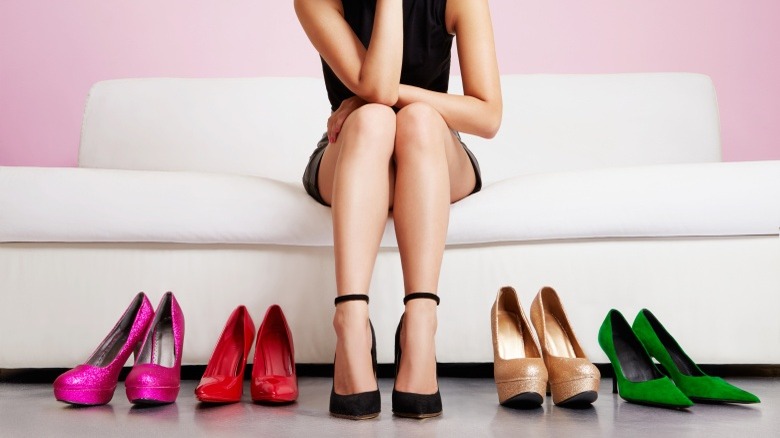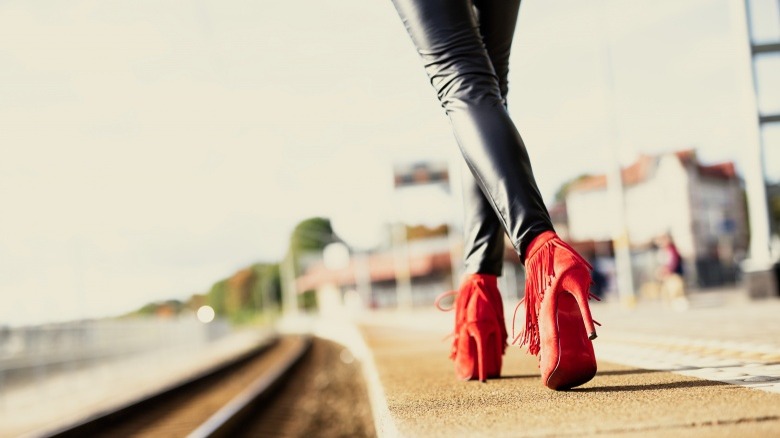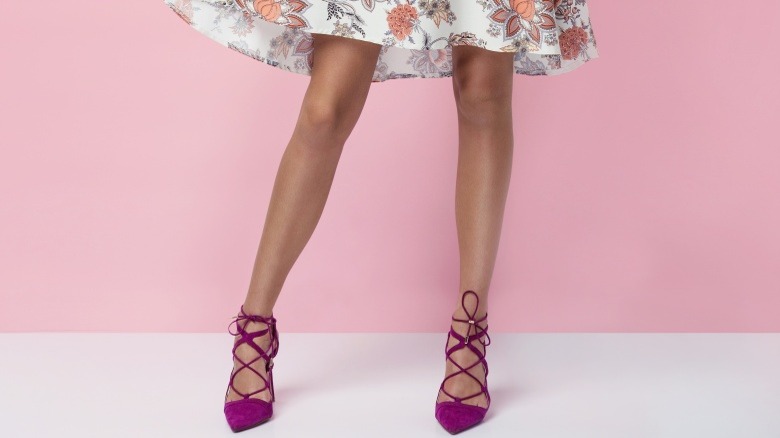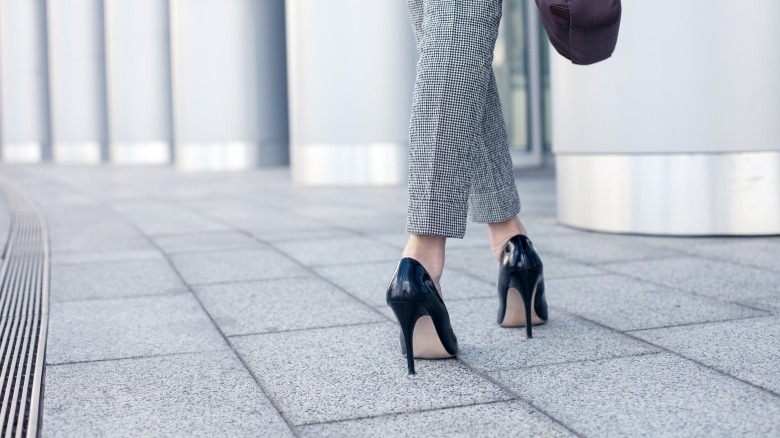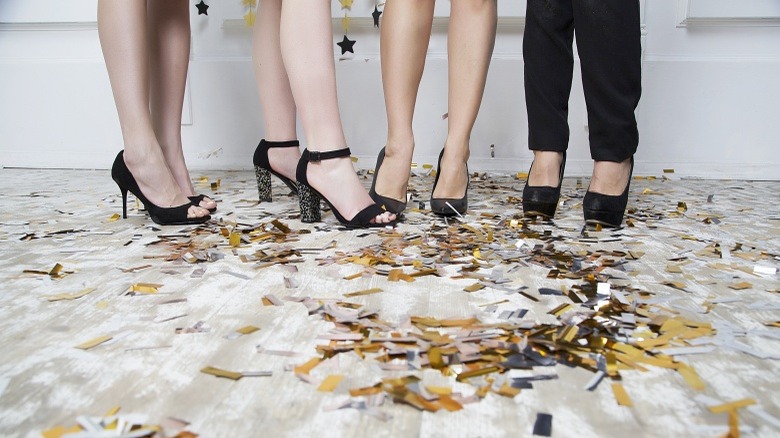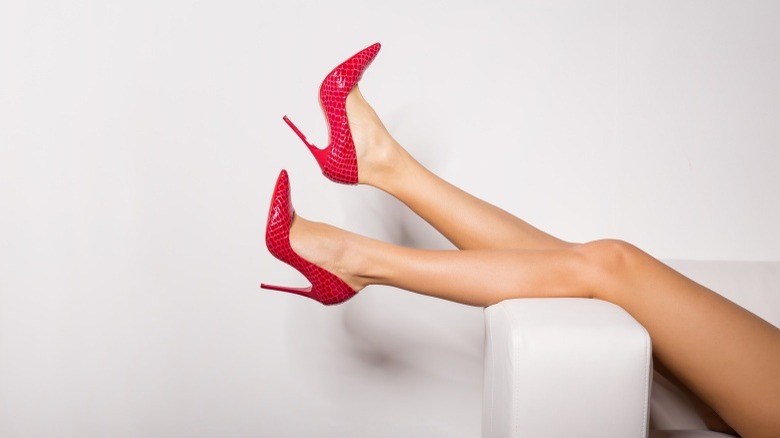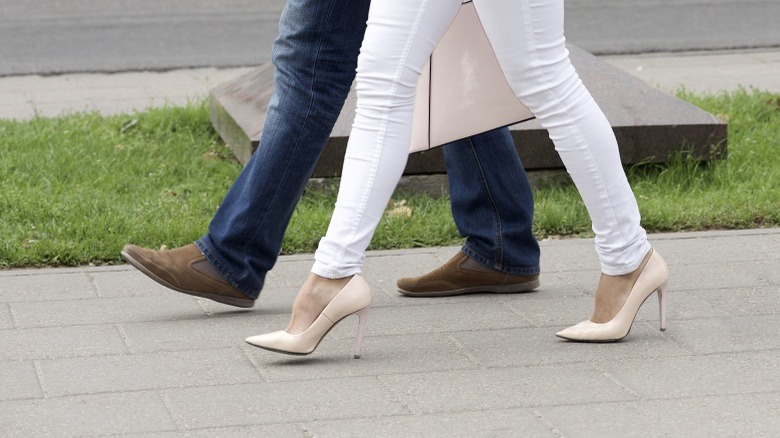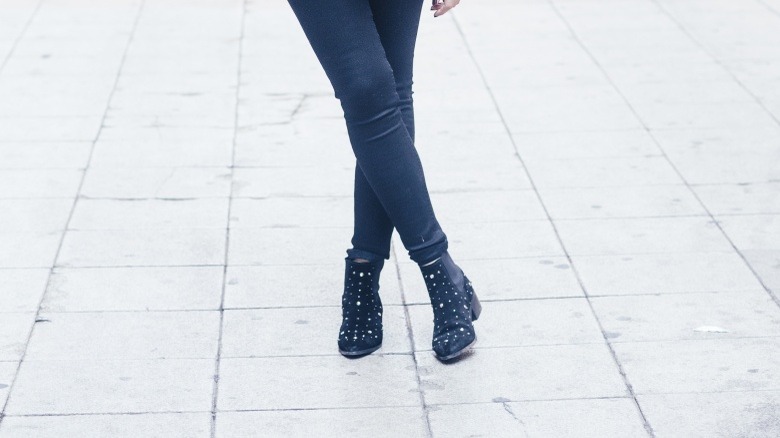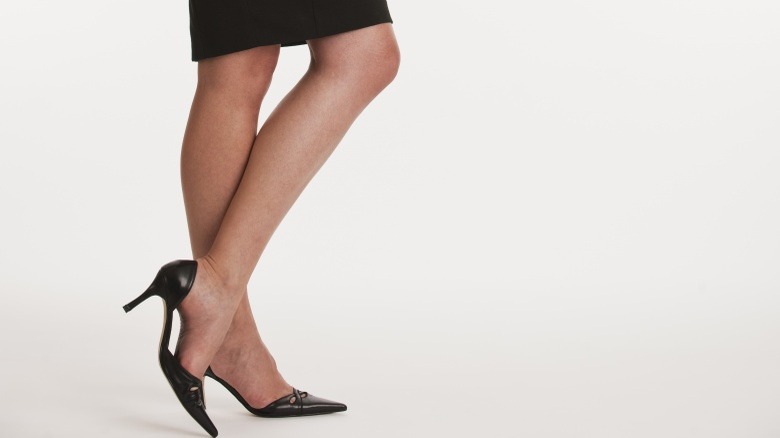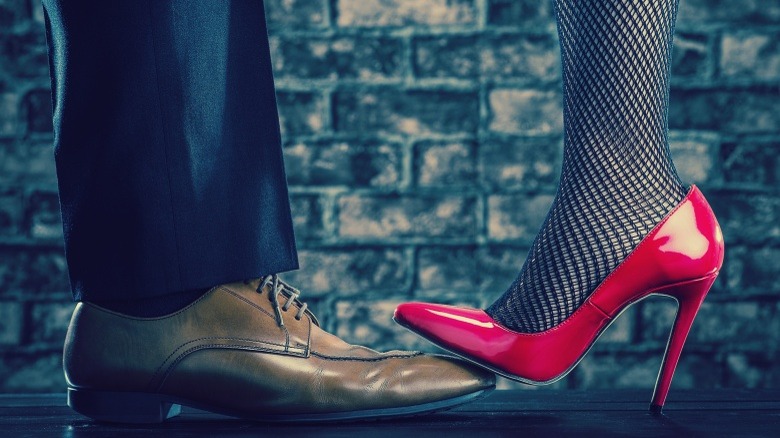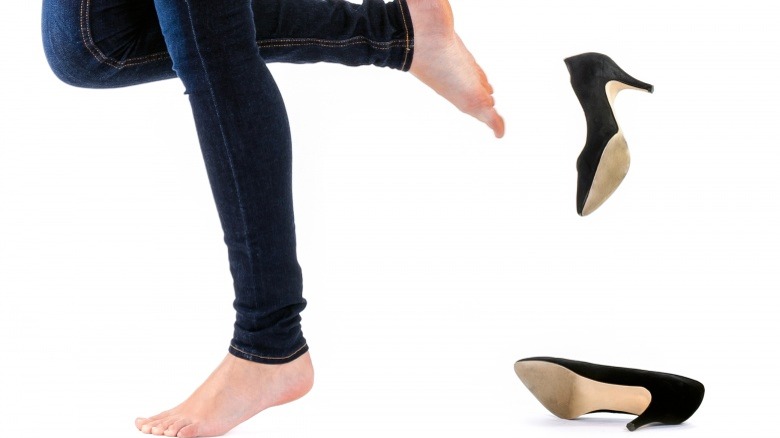The Real Reasons Women Wear Heels
I am a 6'5" woman — when I wear heels. My confidence, my stature, my hip sway, everything is bigger, and some would say better with stilettos strapped to my feet. I can make heads turn, men smirk, and women gasp at the pure sight of me. I love and hate heels for all these reasons and more. And I would guess, no matter how you feel about them, you've probably worn them too.
The Spine Health Institute reports that 72 percent of women will wear high heels in their lifetime. Many wear them daily – 49 percent of 18-24-years-olds, 42 percent of women ages 20-49, and 34 percent of women 50 and over.
To some, heels are a nasty habit. Lumbar spine flattening, posterior displacement of the head, and unwelcome increased pressure on the foot are all results of heel-wearing. They can even cause spasm-producing spinal nerve conditions. Any woman who has gone through an evening standing, walking, dancing or leaning casually against a bar in high heels knows the pulsing, constrictive, numbing pain they can cause.
But we still wear them. Why?
Heels make our walk more attractive
Psychologist Paul Morris and his colleagues did an experiment to test what heels do for a woman's attractiveness. They recorded females walking in flat shoes, and then again in high heels. Like any good experiment, they needed a way to isolate the effects so that other factors didn't muddy the results. So one by one, they decorated 12 different women of varying ages and sizes with glow in the dark dots at specific points along their body. They then had them walk a treadmill in complete darkness so that only their glowing dots were visible – one time dressed in 2 1/2-inch heels, the other, dressed in flats.
The observers couldn't see the women – their age, their weight or their face. They could just see the way they moved when they walked. What happens when you rate a woman on her heel-walking alone? Apparently, a change in gait. With heels, there is a reduced stride, and increased rotation and tilt of the hips. In other words, she struts.
Without any of the other usual indicators of attractiveness, this change in gait alone made the study participants find the heeled-females more attractive.
They make us appear more feminine
Morris and his colleagues decided to take it a step further. They altered the experiment, showing the same videos of the women treadmill-walking in darkness to a new group of participants. But this time, they asked the participants to identify which subjects were females, and which were males. The key to remember here is, all of the walkers were still female.
With every "male" guess, the participant had mistaken a woman in flats for a man. Nothing ground-breaking here, but it confirms scientifically what we already assumed. Heels are girly, ladylike, and feminine.
Certified image consultant, personal stylist and confidence coach, Laurie Brucker, agrees. The subject of "to heel or not to heel?" often comes up with her clients. Her answer? She is an advocate for them because they make you strut.
"When a woman walks in heels, fluid strut is required which forces women to move their hips!" Brucker says. "By moving their hips, whether a subtle strut or an exaggerated cat walk, it reminds women that they are women!"
Heels are office dress code
Imagine going into work one day, confident in your chinos and ballet flats, only to be asked by your employer to leave and come back with heels — or just leave.
That's exactly what happened to Nicole Thorp. Her employer, Pricewaterhouse Coopers, told her she had to wear shoes with a 2-4-inch heel. Thorp refused their demands and was sent home without pay. Although legal and within the company's rights, she took it upon herself to change that and started a petition. It called on the people to make it illegal for a company to require a woman to wear heels to work.
The petition has received over 150,000 signatures and a whole lot of attention from the press and social media, becoming something of a movement. Or at the very least, a hashtag. Type #myheelsmychoice into Twitter to find people all over the world standing flat-footed in solidarity with Thorp — from outraged women sharing similar experiences, to a Swedish handyman who wore bright pink stilettos on the job to prove a not-so-subtle point.
"There's a history behind heels and the damage that it can do to women," Thorp says in an online video interview. "And there's a sexualized element to it, as opposed to a shirt and tie for a man."
They're culturally-ingrained
Fashion journalist and style icon, NJ Goldston, lives in a place where the choice isn't heels or flats. It's sling backs or stilettos. Los Angeles. Tinseltown, La La Land. Where heels are considered the style de rigueur, an entry point into a mutual admiration society.
In her world, your car doubles as a moving closet. "No matter your social circle or neighborhood (except maybe the beach communities), heels are the LA way to amp up a more casual look on the fly when there is no way to go home and dress up after a long work day," Goldston says.
She admits, the LA culture is embracing a more fashion-athletic look. She recently overdressed for a Sunday brunch in Malibu where more casual footwear may have been more acceptable. But that's the exception, not the rule. "LA is such an event-driven town that flats are not really the way to go when you are attending a major luncheon or party."
Popular culture told you to
Look through a rack of women's fashion and lifestyle magazines, and you'll most likely find cover models posing in designer pumps and at least one publication peddling, "Heels that make heads turn."
An article in Glamour touts the many benefits of wearing heels, saying, "Your calf muscles, no matter how weak, look instantly better when you slip on your favorite pumps." Even movies show women wearing heels in impractical situations.
We all know that heels are red carpet staples. From Blake Lively who reportedly told People Magazine that nothing is as "relaxing" as a great pair of Louboutins, to the petite Ariana Grande who almost always seems to be wearing knee high boots with long spiky points. And who could forget the queen of heels herself — Carrie Bradshaw — who was always found pounding the New York pavement in her beloved Blahniks, Choos or Louboutins.
Her former show, Sex and the City, spells out women's love for heels in one quote many fans remember, "The fact is, sometimes it's hard to walk in a single woman's shoes. That's why we need really special ones now and then — to make the walk a little more fun."
It's hard to argue with logic like that.
Heels get you more male attention
Researcher and professor, Nicolas Gueguen, conducted a series of experiments using 19-year-old-women in tight tops and heels or flats. He started out with the old fashioned "I dropped my glove" routine, in which he found it was picked up and returned 60 percent of the time when the women wore flats, and 95 percent of the time when she wore heels.
He also timed how long it would take a man to approach a woman sitting at a bar. The women with flats got approached within 14 minutes. Not bad. Except once the flats came off and the heels were strapped on, that time got cut in half. Pickup lines were happening within seven minutes. Impressive.
Heels help you be more persuasive
In another experiment, Gueguen took the women to the streets. No, not like that.
He had them stop pedestrians to answer a survey about gender equality. The study found that 40 percent of men would respond to a women wearing flats, 60 percent to women in medium heels, and 80 percent of men were all ears when the women were wearing high heels. Hmmm. Could this be applicable to court cases? Business pitches? Or maybe even convincing husbands to wash the dishes?
They symbolize power
One of the first accounts of people wearing heels dates back to 3500 BC. Aristocratic men and women wore them for ceremonial purposes. It has been said the added height set themselves apart — or above — from the social classes. Aristocracy, perhaps, doesn't apply in today's world. But power does.
Women in heels are often women of power. Do a quick search for "business woman," and if the picture is a full-length shot, you can bet that woman is wearing heels. Business organizations like Business in Heels and Leaders in Heels use women dressed in spikey heels on their home pages, or a red pump for their logo.
Sheryl Sandberg, Christine Lagarde, Oprah Winfrey — all named by Forbes as the World's Most Powerful Women – are repeatedly pictured in heels.
Heels even the playing field
As a woman who stands at 6'1" in her bare feet, heels have never been a necessity for me. When I put on 4-inch heels, I become a colossus. People literally have to crane their necks up to talk to me. But for my 5'1" friend, heels are an instant confident boost. Even though her office doesn't require them, she wears them almost daily.
"I came up in restaurants and I worked with mostly men. It was always important to 'show up,' and I would say I often commanded more respect the more well put together I was," she says.
Psychologists at the universities of Liverpool and Central Lancashire might agree. They conducted an experiment in which they digitally lengthened and shortened pictures of women, asking for instant judgments from the viewing participants. The results revealed some harsh truths. The heightened women were judged as more intelligent, assertive, independent, and ambitious — not to mention richer and more successful — than their shorter versions.
Dawnn Karen, M.A., Ed.Mc, of the Fashion Psychology Institute argues that, just like shorter men, women too can get a Napoleon complex. Heels are a way they can gain back some of the power they feel they lack due to their height.
"Wearing heels makes a woman feel in charge because height is the antithesis of power. She always wants to be taller than her opponent. [Wearing heels] literally makes her look down at someone instead of looking up at someone," Karen says.
The choice is yours
All that said, flats have definitely become more widely accepted than they once were. As of August 2016, fashion retailer JD Williams reported that flat shoes outsold heels by 148 percent.
According to a study from consumer analyst Mintel, for the first time, women are buying more flats than heels. It found that 37 percent of women purchased trainers, compared to 33 percent who bought heels (compared to the previous year where both were at 35 percent). And with people like Nicole Thorp leading the charge, more and more women may feel comfortable switching over.
It seems to me, though, that this long-loved, long-hated, long-leg enhancing, back-pain-inducing, head-turning, neck-cranking footwear isn't a decision for women. It's a decision for you.
So, what are your feet wearing tonight?
